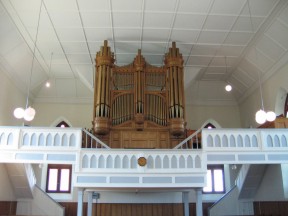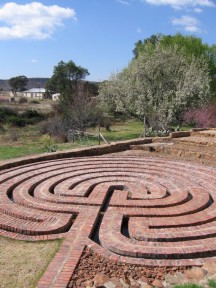|
|
 |
 |
Buildings and Artifacts:
SOME BUILDINGS AND ARTIFACTS
OF INTEREST TO TOURISTS
Adam Kok's House (1843)
Tel:
051 773 0050
Claimed to be the oldest surviving building in Philippolis, this
house, which is thought to have been the residence of Adam Kok
III, has 650-mm-thick walls.
Cannons
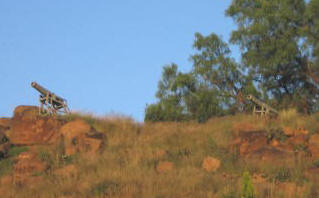
Overlooking the town, from a vantage point on top of a small
hill, are two of the three naval cannon originally presented by
the Cape colonial government to a Griqua chief in the 1840s.
Still in working condition, the cannon are fired during the
town’s annual Witblits festival in April. The cannon may have
been used during the wars between the Boers, the Griquas and the
Basotho. They are listed in an 1861 inventory of Adam Kok III,
who, with some 5000 of his Griqua people, soon afterwards began
their three-year trek to what was then East Griqualand, with
towns such as Kokstad.
Cemetary
The main cemetary in the town is claimed as one of the most
interesting in the Free State. Its graves include those of Griquas, English soldiers, members of the Jewish community, and
a Free State President.
Emily Hobhouse Memorial
The Emily Hobhouse Memorial (1860-1926) commemorates this
English woman, who strove to improve the conditions in the
Anglo-Boer War concentration camps. After the war she became
involved in the social upliftment of young Afrikaner women. She
established a spinning and weaving school in Philippolis in
1905. Emily Hobhouse is buried at the Women’s Memorial in
Bloemfontein, but Philippolis honours her memory.
Old Jail (1872)
Justisie Street
082 550 4421

This has been converted to a privately owned guesthouse, using
cell blocks and other buildings for guest accommodation.
Kruithuis (Powder House)

Built in 1870, the powder house has 48 cm walls. The need from
it arose as Philippolis was on an explosives delivery route.
However, foundation cracks prevented it from being used for its
intended purpose for more than a few years.
Library
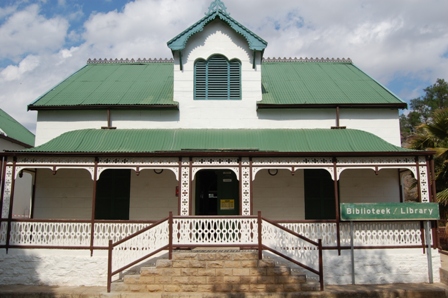
Museum

The Museum
Transgariep at Philippolis, which opened on the 2nd of March
1982. It includes three interesting themes eg. Dr. J. Philip and
the London's Missionary association , the Griqua age of Adam Kok
II and Adam Kok III, Emily Hobhouse and her spin- and
weaveschool and a picture cabinet with early leader figures of
the town. Behind the Museum on the hill the visitor can still
see two cannons which was used by Adam Kok, as well as a ``Griquakraal"
next to the library; this ``kraal" makes out part of the Griqua
Culture.
The Museum Transgariep is housed in the house of old
administrator E.R Grobler, situated in Voortrekker Street. Adam
Kok and his Griquas, who lived in Philippolis since 1826 till
1863, was spiritually guided by the London Missionary
association. Philippolis was named after dr. John Philip,
superintendent of the Association with whose permission the
Griquas lived in Philippolis. In 1862 they moved to Griqualand-East,
after the Republic of Free State bought their land..
The London Missionary Association
In the Museum Transgariep we relive the hard work done by the
London Missionary Association, in the years 1823 to 1862, in the
region north of the Orange river. In this room we find various
photos and books of the different British missionaries who
worked in Philippolis.
Dr. John Philip, after whom Philippolis is named, takes the
central place in this room. Here his well known book -
Researchers in South Africa (1828) can be seen. Dr. Philip acted
as the Superintendent of the Missionary Association in South
Africa since 1819 till 1849. The history of Philippolis is told
by sketches of the Missionary Association till 1862 when
Philippolis was handed over to the Republic of Free State.
Adam Kok
Situated in the Museum Transgariep is the bedroom, livingroom
and kitchen, furnished in the way it was in the time of Adam
Kok. In the livingroom the visitor can see the furniture of Adam
Kok's time: a big table made of Olienwood, some chairs, a wall
unit and a Stinkwood bench, as well as a display cabinet with
some antiques.
In the bedroom is an iron bed which looks like the one on which
Adam Kok III could have slept on also another bed and a closet.
In the kitchen is a big old traditional kitchen table in the
middle of the room. Also a cupboard and shelf with valuable
kitchen utensils like copper kettles, porcelain bowls, dishes
and spoons.
In the backyard of the Museum,
visitors can visit the horsemill
and -stable. Horsemills are very scares. What makes this mill so
valuable is that it is still in good working condition. The
theme museum of Transgariep is the only one in the Free State
with one of these mills. The grain is milled between the
millstone. A horse pulls the mill and that is why the stable is
so close to the mills.

The griquas as Adam Kok, loved horses. In the stable original
Yellowwood beams and a feeding krib can still be seen.
Picture Cabinet
From the bedroom one walks into the Picture Cabinet. Here the
visitors can see the beautiful photos of the leaders who played
a important role in the history of Philippolis. There are
photos, drawings and even paintings of the important figures
like Adam Kok II and Adam Kok III, missionaries of the London
Missionary Association like dr. Philip and John Campbell.
Important Afrikaner leaders like dr. Tobie Muller and C.W.H van
der Post and even ds. Colin Frasier, who where the preacher in
Philippolis for so many years, are represented in this room.
Emily Hobhouse
The two rooms which is furnished for Emily Hobhouse and her
spin- and weaveschool in the backyard, is also one of its kind
in them museums in the Province. In the first room the visitor
is introduced to her. There are a variety of photos which
displays her life to us. With the start of the Second Freedom
War in 1899 she too the misery of the Boerwives and children on
herself. She wrote different article and books about the war.
The most important of which is The Brunt of to War and Where it
fell (1902) The second room shows us how her first spin- and
weaveschool, which she started in 1905 at Philippolis, to show
the Boergirls how to spin and weave so they could bring a
contribute to the economical restore of their families and the
Afrikaner nation after the War.
In the backyard of the Museum Transgariep ``Stookketel"
(distilling kettle) Alcoholism play an important role in the
social life of the Griqua tribe. with this well kept
``Stookketel" which comes from the farm Oranjesig in the
district of Philippolis, the Museum makes its own spirits
(witblits) of grapes, peaches and other fruits. Because of
constitutional regulations the witblits is not sold but offered
to visitors to taste.
Griqua Huts
The Griquahuts north of the Museum Transgariep makes out an
important part of the Griqua culture. This small ``Griquakraal"
at the start of the hill on which the cannons of Adam Kok III
stands, shows us the lifestyle of the Griquas who lived here
from 1826 - 1862.
The Municipality of Philippolis restored the huts on traditional
way by asking some Griqua women to weave the huts. The huts are
made of woven ``biesiematte" (woven mats) which is put on a
frame of tree branches and sown together. Also in this open-air
museum stands the ``cars" of the Griquas - a feather wagon
(verewa) and goat wagon (bokwa). With these wagons the Griquas
moved to Griqua- land-East in 1862
Old Church
Nederduits Gereformeerde Kerk
051 773 0014
Opened in 1871, the church was build on the site of the former
Griqua church, in which the first minister, Colin Fraser,
performed services from 1863. Fraser, who came from Scotland,
was the father-in-law of Free State President M T Steyn. He
retired only in 1907. The church is famous for its pulpit, which
is carved from wild olive and erected with no nails, screws or
bolts, and its its fine organ. (051 773 0065)
Oom Japie se Huis
Tel:
051 773 0050
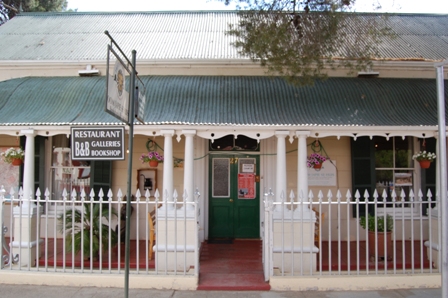
This Victorian house, was restored by its then owner, Japie
Janse van Rensburg (Oom Japie), to such good effect that it won
a South African Institute of Architets 1997 award for the
best-restored vernacular house in South Africa.
Starry Nights Karoo Cottages
Accommodation
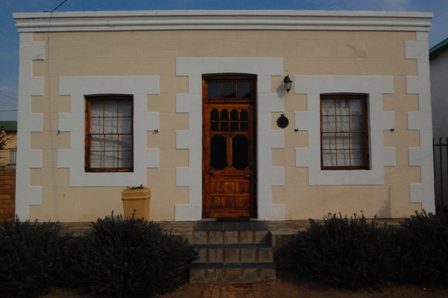
Sunette: 082 89 24680;
[email protected]
Tomkins Koppie
This hill was named after the commanding officer of the British
troops that occupied Philippolis during part of the Anglo-Boer
War. Tomkins and his men defended the koppie without food dor
water for several days while they were attacked by Boer forces.
Laurens van der Post Memorial Centre
051 773 0050
Labyrinth at Memorial
This centre is the first tourist attraction for tourists
entering the town from the north. It commemorates this famous
son of Philippolis, born in the Van der Post house, which is one
of the town’s many national monuments, in Colin Fraser
Street.The memorial gardens have been designed on the theme “A
Journey Through Life” and a recent addition has been a stylised
labyrinth and amphitheatre. The centre itself includes the
writer’s study, which was moved from London to South Africa with
its 1600 books, the writer’s desk and other furniture and
photographs. The centre was opened in 1998, less than two years
after the writer’s death, by Chief Mangosuthu Buthelezi. The
main building and some of the land was donated by members of the
Philippolis community while sponsorship funding was contributed
by Lucia van der Post, the writer’s daughter, and the Van der
Post Memorial Trust. The centre includes a double-storey
Artist’s Retreat, a self-catering guesthouse.
|
 |
 |
|
Nuusbriewe:
|
 |
|










